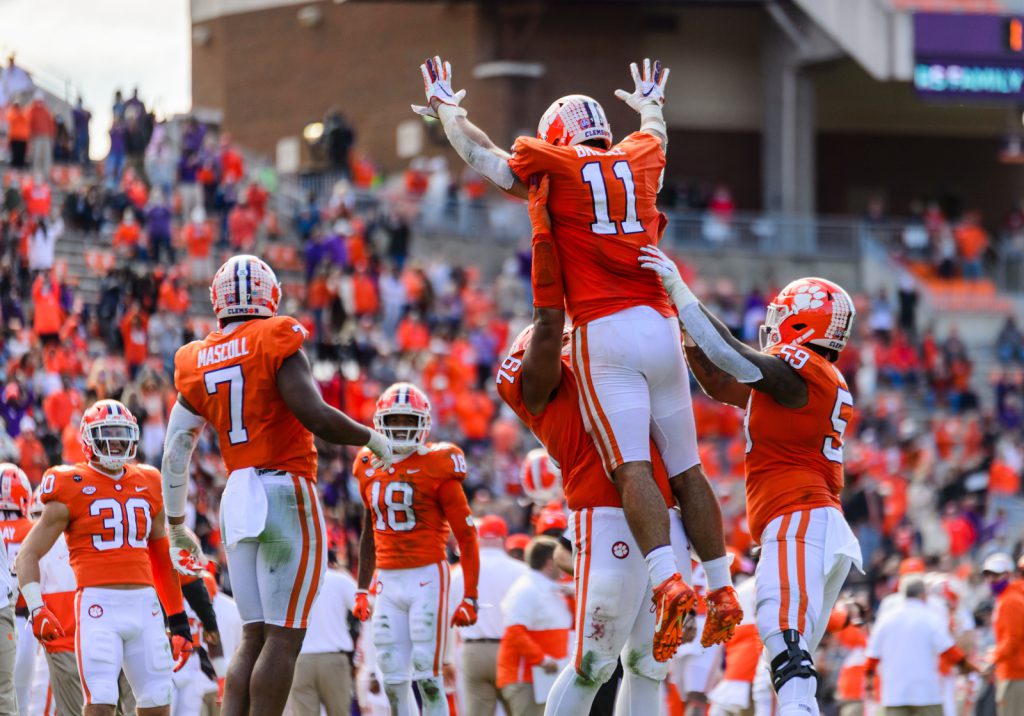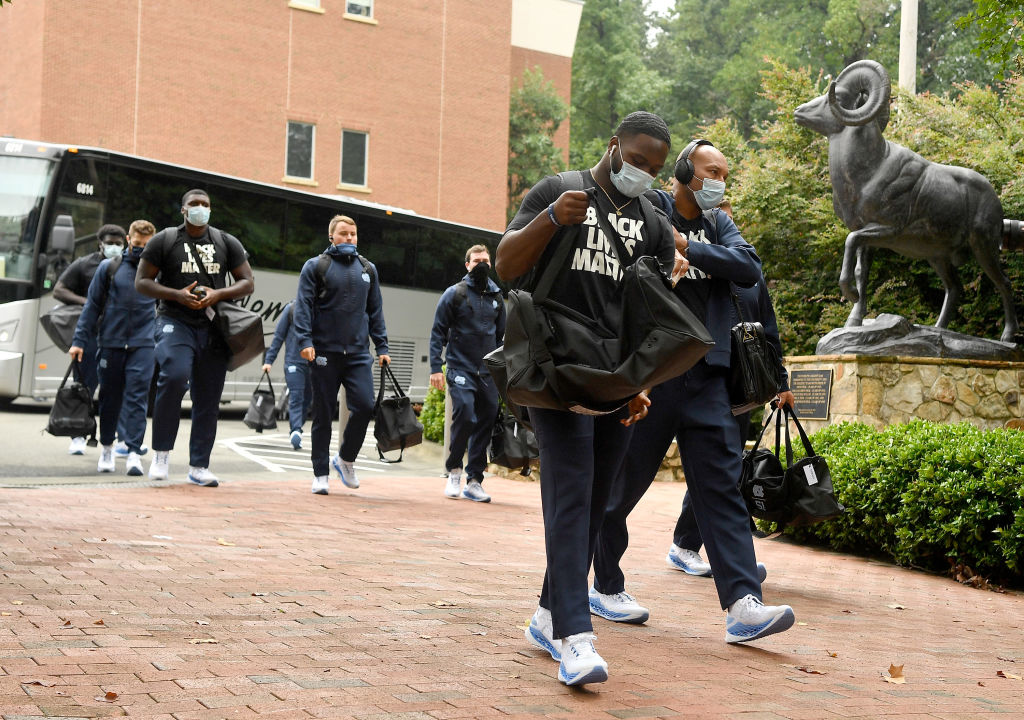Brotherhood and Anti-Blackness in College Football

This article was originally published at Black Perspectives (the blog of the African American Intellectual History Society) and has been republished with permission.
Wide receiver Jaylen Waddle was selected No. 6 overall by the Miami Dolphins in the 2021 NFL Draft. During his post-selection press conference, Waddle matter-of-factly responded to each request for a comment. The only time his speech became animated was near the end, as he learned that his teammate DeVonta Smith was drafted No. 10 overall to the Philadelphia Eagles.
“What’s it mean for both you guys to go in the top 10?” he’s asked.
“Aww man, it’s just a moment you get to share with your brother,” Waddle replies, after raising his voice in excitement and shifting in his seat to make sure he heard right. “That’s my brother, man. It’s just tremendous. It’s a lot of emotion. I almost tear up, and I’m not a real emotional guy. It’s just a special moment you get to share with your brother.”
The joy in Waddle’s voice is palpable as he describes the importance of these selections, but he quickly recovers. After acknowledging his former teammates, he regains his dispassionate tone and continues chatting with the journalists.
This is an insightful interview for me as an anthropologist who has spent almost 10 years learning from Black college football players. Waddle’s reaction to Smith being drafted is representative of ways I’ve noted that Black players care for one another. However, understanding the historical and contemporary configurations of the college football system is key to understanding the reason for this response.
It’s been quite a year for college football.
In August 2020, the Pac-12 and Big 10 announced they would postpone all fall sports to account for the threat of COVID-19. But the decision didn’t last long. When the remaining three conferences that make up the Power Five—the ACC, Big 12, and SEC—didn’t cancel their seasons, the original two reconsidered. Despite a pandemic that has disproportionately affected Black, Indigenous, and Latinx people, season and post-season play resumed for all Power Five conferences by November.
The University of Alabama, the team Waddle and Smith played for, won the National Championship on January 11.
Simultaneously, the NCAA managed an antitrust lawsuit in the Supreme Court, calls to amend its “name, image, and likeness” rules, and pressure to allow college athletes to unionize. These matters stem from how the governing body of collegiate athletics defines amateurism and limits financial compensation for athletic labor. Of note, though, is that data collected by the National College Players Association suggest that billions in generational wealth is lost by Black college football and men’s basketball players.
Finally, braided into these bio-physical and economic issues that particularly harm Black athletes, the sport was forced to respond to the police murder of George Floyd in May 2020. In the months immediately following, teams all over the country took part in campaigns to declare their solidarity with their athletes, specifically their Black athletes. This included media messages, public statements from coaches, team-sponsored events, and NCAA approval to include social justice statements on jerseys.
There was an energy in these responses that was meant to show care for players. However, as explained by sports historian Louis Moore, “They are putting a corporate Band-Aid on a problem instead of dealing with it.”
The deeply rooted anti-Black framework of the college football system cannot be addressed with a pithy hashtag or a new logo.
The problem is the anti-Blackness and racism that are woven into the fabric of the current system. Football has its origins among the Northeastern white elite of the Ivy League in 19th-century United States. Historian Charles H. Martin details the intimacy of white supremacy and college spaces of play to describe how Black players were systemically excluded at historically white institutions through the 1960s. Currently, talent and competition are concentrated in the Southeast and Black men—students who weren’t allowed to initially enroll in originating and Power Five universities—are overrepresented in the sport. These and other changes are important because they reference a contemporary tension: Despite these shifts, the college football system continues to rely on its foundational white supremacist ideals.
Thus, the flimsy “corporate Band-Aid” on these anti-Black issues is apparent in the countless incidents that occurred after last summer’s deluge of public messaging. The University of Texas, University of Alabama, and University of Florida were challenged to deal with the racist origins of their school’s sport traditions. Several Black college coaches were fired from their positions and NFL teams failed to increase their number of Black head coaches. However, a white coach accused of racist behavior was fired and quickly rehired by an NFL team. Race norming strategies in the NFL systemically limited compensation to former Black players for concussion-related injuries. And this is just a sampling.
These issues didn’t start with the pandemic, and they are not random, individual incidents. Instead, they highlight the actual framework of the sport and point to interconnected systems that inform players’ lives and experiences. In the words of scholar Christina Sharpe, this is a holistic environment, known as “the weather,” that is anti-Black. Both on and off the field, Black players must navigate this atmospheric anti-Blackness. And unfortunately, the messaging is consistently clear: The systems and spaces that rely on the athletic bodies of these young Black men are concerned with their labor on the field but not their lived experiences off it. No matter how much these institutions claim to be committed to their players, there is overwhelming evidence to show the limits of that care.
In short, the deeply rooted anti-Black framework of the college football system cannot be substantially addressed with a pithy hashtag or a new logo or a fairly neutral public statement. For all its attempts to explain it in the contrary, college football is an institution dependent upon and implicated by racial capitalism, labor exploitation, and structural violence.
Since the majority of football players are Black men, let’s consider how they navigate their years in college. Waddle’s embodied and linguistic response during the press conference—showing excitement to the news, listing a cohort of former teammates, calling them his brothers—represents how these young players find relative success. His use of “brother” is purposeful; what he’s referencing is far more than just a close relationship of teammates.
In research I plan to publish, I argue for the difference between football teammates and football brothers. The latter refers to the racialized and gendered experiences that bond the young Black men who end up on college teams together, particularly given how they must deal with the anti-Black environment that populates their social worlds. Over time, they choose to become brothers as a reaction to the noticeably racist systems that surround them. Because they encounter praise on the field for their athletic feats but various forms of discrimination beyond it—something media scholar Samantha Sheppard defines as “sporting blackness”—Black athletes create and cultivate family relationships with others who can relate to that experience.
A recent conversation with a defensive lineman seems particularly relevant. When asked who among his friends, at home and at school, he was closest to, he replied without pause, “It’s a brotherhood here like it’s a brotherhood there. You got brothers from the same mother, you got brothers that you learn to love, and you got brothers from the same struggle.” I was struck by his decision to classify his Black teammates as “brothers you learn to love” because it speaks to a certain sentiment. Rather than being biological brothers from the same mother or brothers who share a similar upbringing, this player learned to love his football brothers through shared experiences on the field, in the classroom, on campus, and in their university’s home city.
I’ve learned that Black players don’t often verbalize their care for one another. It’s not something they readily speak to or theorize, but it is acted out in seemingly innocent, ordinary moments. And that’s why Waddle’s press conference was so interesting.
Last year’s corporate fixes from sport institutions were responses to a sensational act of violence, but political scientists Jennifer Chudy and Hakeem Jefferson explain the temporary nature of this kind of support. Instead, Black players respond to the everydayness of anti-Blackness by creating a football brotherhood with those they “learn to love.” At a moment when he couldn’t deny his support for Smith, Waddle gave a nod to this relationship.
Since the unprecedented pandemic season, the implementation of new economic guidelines for college athletes, and last summer’s calls for “racial justice,” I wonder what fall 2021 play will look like. What is guaranteed in the uncertainty about the upcoming season is that Black players will continue to care for and rely on one another in ways that differ from what programs expect. There is something to be gained by taking seriously the ways they persist in spite of and because of the incidents that continue to impact their everyday lives. No matter what, these Black football brothers will make family amid systemic failure.
My attention this season, as usual, will be attuned to these relationships off the gridiron.

































